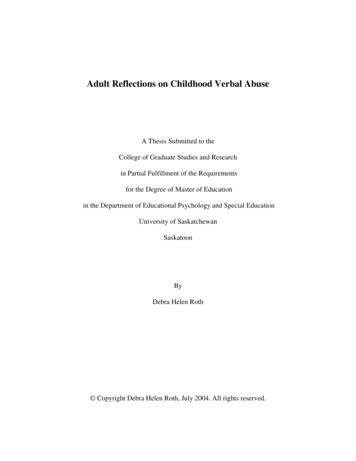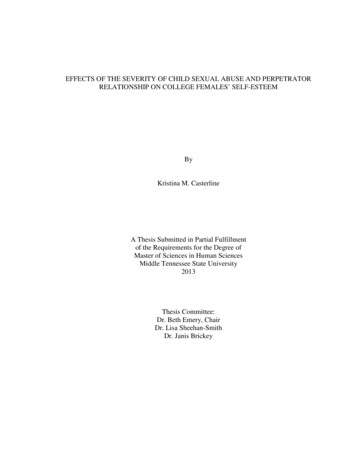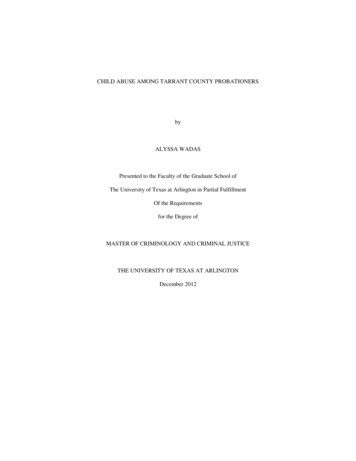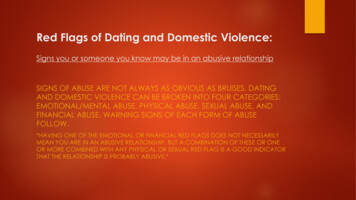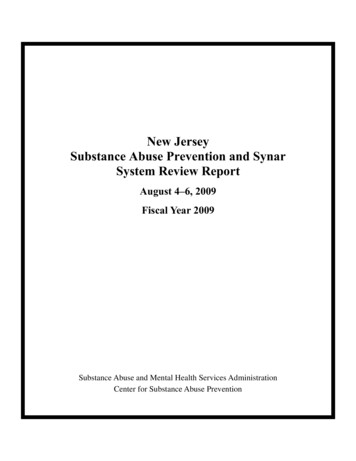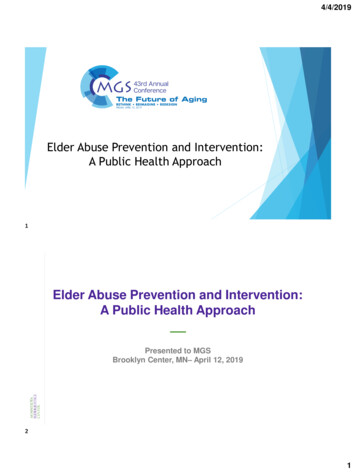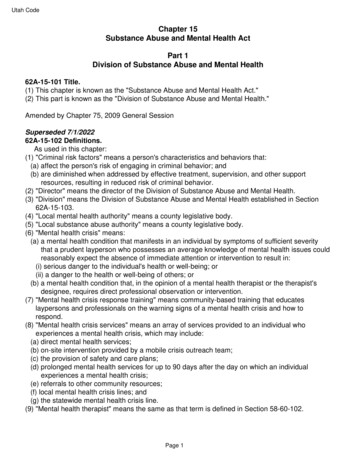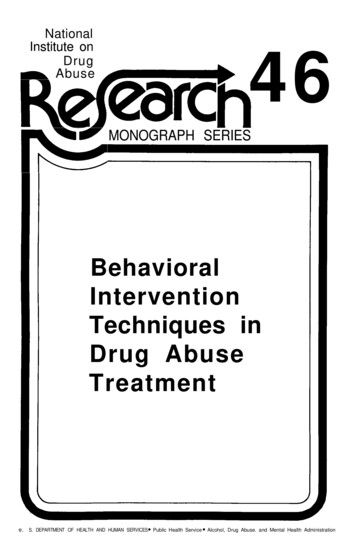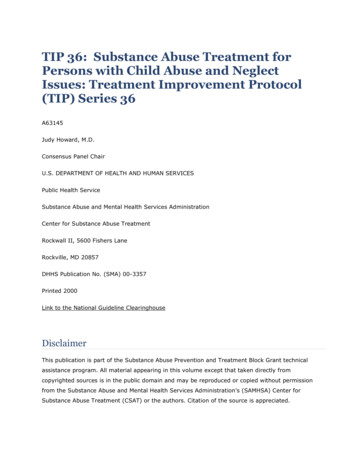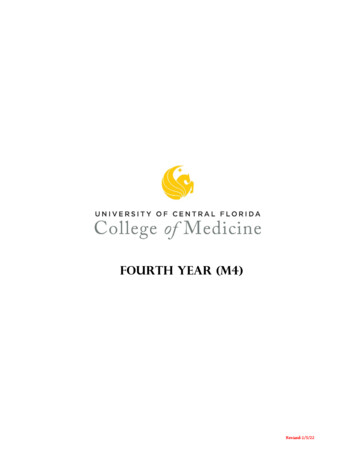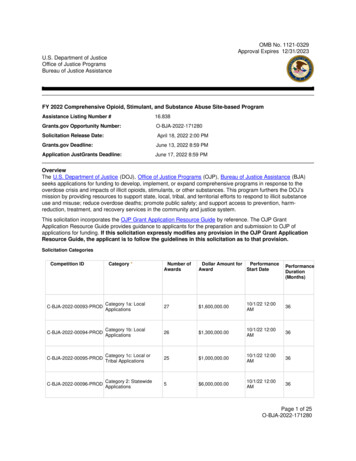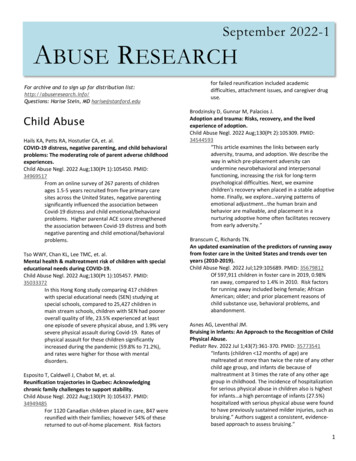
Transcription
September 2022-1ABUSE RESEARCHFor archive and to sign up for distribution list:http://abuseresearch.info/Questions: Harise Stein, MD harise@stanford.eduChild AbuseHails KA, Petts RA, Hostutler CA, et. al.COVID-19 distress, negative parenting, and child behavioralproblems: The moderating role of parent adverse childhoodexperiences.Child Abuse Negl. 2022 Aug;130(Pt 1):105450. PMID:34969517From an online survey of 267 parents of childrenages 1.5-5 years recruited from five primary caresites across the United States, negative parentingsignificantly influenced the association betweenCovid-19 distress and child emotional/behavioralproblems. Higher parental ACE score strengthenedthe association between Covid-19 distress and bothnegative parenting and child emotional/behavioralproblems.Tso WWY, Chan KL, Lee TMC, et. al.Mental health & maltreatment risk of children with specialeducational needs during COVID-19.Child Abuse Negl. 2022 Aug;130(Pt 1):105457. PMID:35033372In this Hong Kong study comparing 417 childrenwith special educational needs (SEN) studying atspecial schools, compared to 25,427 children inmain stream schools, children with SEN had pooreroverall quality of life, 23.5% experienced at leastone episode of severe physical abuse, and 1.9% verysevere physical assault during Covid-19. Rates ofphysical assault for these children significantlyincreased during the pandemic (59.8% to 71.2%),and rates were higher for those with mentaldisorders.Esposito T, Caldwell J, Chabot M, et. al.Reunification trajectories in Quebec: Acknowledgingchronic family challenges to support stability.Child Abuse Negl. 2022 Aug;130(Pt 3):105437. PMID:34949485For 1120 Canadian children placed in care, 847 werereunified with their families; however 54% of thesereturned to out-of-home placement. Risk factorsfor failed reunification included academicdifficulties, attachment issues, and caregiver druguse.Brodzinsky D, Gunnar M, Palacios J.Adoption and trauma: Risks, recovery, and the livedexperience of adoption.Child Abuse Negl. 2022 Aug;130(Pt 2):105309. PMID:34544593“This article examines the links between earlyadversity, trauma, and adoption. We describe theway in which pre-placement adversity canundermine neurobehavioral and interpersonalfunctioning, increasing the risk for long-termpsychological difficulties. Next, we examinechildren's recovery when placed in a stable adoptivehome. Finally, we explore varying patterns ofemotional adjustment the human brain andbehavior are malleable, and placement in anurturing adoptive home often facilitates recoveryfrom early adversity.”Branscum C, Richards TN.An updated examination of the predictors of running awayfrom foster care in the United States and trends over tenyears (2010-2019).Child Abuse Negl. 2022 Jul;129:105689. PMID: 35679812Of 597,911 children in foster care in 2019, 0.98%ran away, compared to 1.4% in 2010. Risk factorsfor running away included being female; AfricanAmerican; older; and prior placement reasons ofchild substance use, behavioral problems, andabandonment.Asnes AG, Leventhal JM.Bruising in Infants: An Approach to the Recognition of ChildPhysical Abuse.Pediatr Rev. 2022 Jul 1;43(7):361-370. PMID: 35773541“Infants (children 12 months of age) aremaltreated at more than twice the rate of any otherchild age group, and infants die because ofmaltreatment at 3 times the rate of any other agegroup in childhood. The incidence of hospitalizationfor serious physical abuse in children also is highestfor infants a high percentage of infants (27.5%)hospitalized with serious physical abuse were foundto have previously sustained milder injuries, such asbruising.” Authors suggest a consistent, evidencebased approach to assess bruising.”1
Liu RT, Walsh RFL, Sheehan AE, Cheek SM, Sanzari CM.Prevalence and Correlates of Suicide and Nonsuicidal Selfinjury in Children: A Systematic Review and Meta-analysis.JAMA Psychiatry. 2022 Jul 1;79(7):718-726. PMID: 35612875“Considerably less is known about self-injuriousthoughts and behaviors (SITBs) in preadolescencethan older age groups, owing partly to the commonview that young children are incapable of suicidalthoughts. Yet, preadolescent suicide has increasedin recent years and is now the fifth leading cause ofdeath in this age group Prevalence for lifetimesuicidal thoughts, suicide attempts, and nonsuicidalself-injury among preadolescents were 15.1%, 2.6%,and 6.2%, respectively, in community samples.These data suggest that approximately 17.0% ofpreadolescents with suicidal ideation transition toattempting suicide Among interpersonal factors,child maltreatment [towards] and parental support[against] had the strongest effects on suicidalideation.”Adult Manifestationsof Child AbuseChen VH, Caron J, Goddard B, Eng SM, Ades V.Polyvictimization and Psychiatric Sequelae Associated withFemale Genital Mutilation/Cutting (FGM/C).J Immigr Minor Health. 2022 Aug;24(4):1020-1028. PMID:35217978Of 80 adult women seen in a NYC program forpatients who had experienced Female GenitalMutilation/Cutting (FGM/C), 53.8% also experiencedphysical abuse, 43.8% emotional abuse, 43.8%sexual abuse, 25% forced marriage, 16.3% childmarriage, and 1.4% sex trafficking. There was a highdegree of polyvictimization, with 51.2%experiencing 3 or more of the aforementionedabuses. Having FGM/C on or after age 13 or having ahigher total abuse score was also found to be strongpredictors of depression and PTSD Health careproviders should understand the high risk ofpolyvictimization when caring for this patientpopulation.”Demakakos P, Steptoe A, Mishra GD.Adverse childhood experiences are associated withincreased risk of hysterectomy and bilateral oophorectomy:A national retrospective cohort study of women in England.BJOG. 2022 Aug;129(9):1481-1489. PMID: 34978369From a national study of British women, and aftercontrolling for multiple factors, ACE score had agraded association with hysterectomy (surgicalremoval of uterus/womb) and bilateraloophorectomy (surgical removal of both ovaries).Compared with women with no ACE, those with 3ACE had 2.01 times the odds of hysterectomy, and2.61 times the odds of bilateral oophorectomy. Theexclusion of women with cancer history made theassociations stronger, especially for younger women– 2.97 odds of hysterectomy and 3.48 for bilateraloophorectomy. “Our working hypothesis is thatACE-induced chronic stress and resultant hormonaland immune imbalances are related to the observedassociations.”Rocca WA.Adverse childhood experiences and gynaecological surgery.BJOG. 2022 Aug;129(9):1490-1491. PMID: 35094477In this commentary on an article showing that ACEswere associated with both increased risk of removalof uterus and ovaries in women as well as at ayounger age, “There is an urgent need to educategynaecologists, psychiatrists and generalpractitioners about the pervasive harmful sequelaeof adverse childhood experiences, including theincreased risk of gynaecological diseases andsurgery The high rate of hysterectomy andoophorectomy among young patients with adversechildhood experiences may lead to increasedcardiovascular disease, osteoporosis, cognitivedecline and mortality. Provision of adequate mentalhealth care and emotional support in childhood,adolescence and adulthood to women who haveundergone adverse childhood experiences couldhelp to reduce avoidable gynaecological surgery,and its unintended consequences.”Wood SK, Ford K, Madden HCE, et. al.Adverse Childhood Experiences and Their Relationship withPoor Sexual Health Outcomes: Results from Four CrossSectional Surveys.Int J Environ Res Public Health. 2022 Jul 21;19(14):8869.PMID: 35886718“This study explored associations between 4 adultACE surveys from different regions in the UK andsexual health outcomes. ACE count was a consistentand significant predictor of having early sex ( 16years), having an accidental teenage pregnancy,becoming a teenage parent, or having a lifetimediagnosis of a sexually transmitted infection, forboth males and females. Odds of these outcomeswere between three and seven times higher forthose with 4 ACEs compared to those with noACEs.”2
Cleland L, McLeod GFH, Dhakal B, et. al.Childhood maltreatment and the menopause transition in acohort of midlife New Zealand women.Menopause. 2022 Jul 1;29(7):816-822. PMID: 35796554For 468 New Zealand women, after controlling forboth childhood and adult factors relating tomenopause, those who experienced severechildhood sexual abuse involvingattempted/completed sexual penetration had twicethe rate of entering or completed menopausaltransition at age 40 compared to those with noreported child sexual abuse.Roberts AL, Liu J, Lawn RB, et. al.Association of Posttraumatic Stress Disorder WithAccelerated Cognitive Decline in Middle-aged Women.JAMA Netw Open. 2022 Jun 1;5(6):e2217698. PMID:35771577“Of 12 270 trauma-exposed middle-aged women,individuals with high levels of PTSD symptomsexperienced significantly worse cognitive decline inlearning and working memory as well aspsychomotor speed and attention compared withthose with no PTSD symptoms. These findings werenot fully explained by demographic characteristics,behavioral factors, or health conditions, includingcomorbid depression.”Schickedanz HB, Jennings LA, Schickedanz A.The Association Between Adverse Childhood Experiencesand Positive Dementia Screen in American Older Adults.J Gen Intern Med. 2022 Aug;37(10):2398-2404. PMID:34782990From a survey of 1223 elders with a mean age of73.4 years, greater exposure to ACEs wasindependently associated with higher probability ofa positive dementia screen in older adulthood. Thislink was strongest in adults aged 65-74 and in thosewith four or more ACEs. Older adults with childhoodexperiences of emotional abuse, sexual abuse,exposure to intimate partner violence, or a parent’smental illness had the greatest likelihood of apositive screen for dementia. Differences in chronicconditions, including hypertension, diabetes,cardiovascular disease, prior stroke or heart attack,severe mental illness, and alcohol use did notchange the association between ACEs and positivescreen for dementia.Rodriguez-Miguelez P, Looney J, Blackburn M, et. al.The Link Between Childhood Adversity and CardiovascularDisease Risk: Role of Cerebral and Systemic Vasculature.Function (Oxf). 2022 May 26;3(4):zqac029. PMID: 35774591“The medial prefrontal cortex (mPFC) is a coreregion in the brain that handles emotions and isdirectly involved in the cardiovascular response tostress by increasing vascular resistance [tighteningthe muscles around the blood vessels, making itharder for blood to go through].” For 45 adults,average age 33 years, 22 of whom had experiencedACEs, and using multiple assessment methods inmultiple vascular areas (small, medium, and largeblood vessels), there was a graded responsebetween increasing ACEs and more dysfunction inthe mPFC as well as increased vascular resistance.“These findings provide novel insights into thepotential role that the brain and the peripheralvasculature may have in connecting adversechildhood events to the increased risk ofcardiovascular disease.”Khoury JE, Dimitrov L, Enlow MB, et. al.Patterns of Maternal Childhood Maltreatment andDisrupted Interaction Between Mothers and Their 4-MonthOld Infants.Child Maltreat. 2022 Aug;27(3):366-377. PMID: 33853345“Maternal childhood maltreatment (MCM) isassociated with parenting disruptions which maycontribute to the intergenerational transmission ofnegative health and social outcomes.” In this studyof 179 mothers and their 4-month-olds, authorsfound that maternal childhood physical abusehistory was associated with negative or intrusivematernal behavior, maternal-experienced childhoodphysical neglect with confusion about maternal role,and mothers who had experienced multiple types ofchildhood maltreatment displayed more maternalwithdrawal.”AdolescentsMortier P, Alonso J, Auerbach RP, et. al.Childhood adversities and suicidal thoughts and behaviorsamong first-year college students: results from the WMHICS initiative.Soc Psychiatry Psychiatr Epidemiol. 2022 Aug;57(8):15911601. PMID: 34424350“Web-based self-report surveys administered to20,842 incoming college students from ninecountries (response rate 45.6%) assessed lifetimesuicidal ideation, plans and attempts along withseven childhood adversities (CA).” The transitionfrom ideation to plan was best explained by anincreased number of CA types. The transition toattempts were best explained by the frequency ofspecific CA types. Authors calculated that 63% ofsuicidal ideation and 30-47% of suicidal thought andbehavior transitions were associated with CAs.3
Espelage DL, Liu GS, Valido A, et. al.Violence perpetration prevalence among Colorado (UnitedStates) high school students across gender, racial/ethnic,and sexual identities.Prev Med. 2022 Aug;161:107146. PMID: 35810935Using data from 9th-11th grade students at 20 highschools in Colorado, “Compared to femaleadolescents, male adolescents reported significantlyhigher perpetration rates for: any sexual violence(27% vs. 17%), sexual harassment (26% vs. 15%),unwanted sexual contact (8% vs. 4%), andhomophobic name-calling (61% vs. 38%) whichheld true across sexual identity and race/ethnicity.”Bengtsson TT, Olsen RF, Lausten M.The role of mental health problems in out-of-home careyouths' educational pathways: Quantitative and qualitativeanalysis of Danish longitudinal data.Child Abuse Negl. 2022 Sep;131:105782. PMID: 35816902Of 525 Danish youth in care, four educationalpathways were identified: 1) the typical academicpathway, 2) the typical vocational pathway, 3) thedisrupted pathway, and 4) the non-completionpathway. Mental health problems were found to bean essential predicting factor for the disruptedpathway, and were important in the noncompletion pathway along with multiple otherfactors such as lack of social support, drug use, andhomelessness.Santos M, Burton ET, Cadieux A, et. al.Adverse childhood experiences, health behaviors, andassociations with obesity among youth in the United States.Behav Med. 2022 Jul 6:1-11. PMID: 35792894From a national survey of children aged 10-17,25.3% experienced 1 ACE and another 25.9% 2 ormore ACEs. “Having ACEs was related to excessscreen time and inadequate sleep, andindependently associated with obesity.”Domestic Violence –Effects on ChildrenDebelle G, Efstathiou N, Khan R, et. al.The Typology and Topography of Child Abuse and Neglect:The Experience of a Tertiary Children's Centre.Int J Environ Res Public Health. 2022 Jul 5;19(13):8213. PMID:35805871“A retrospective study of the case records of 452children referred to a major UK children's tertiarycentre for suspected child maltreatment wasundertaken. Child maltreatment was substantiatedin 65% of referred cases. Domestic violence andabuse and the child's previous involvement withstatutory bodies were associated with casesubstantiation. Physical abuse predominated, withsoft tissue injuries, including dog bites and burns,most frequent. Burns were related almostexclusively to supervisory neglect. There were alsocases of medical neglect. Emotional abuse wasassociated with exposure to domestic violence andabuse and to self-harm.”Dennis CL, Marini F, Dol J, Vigod SN, Grigoriadis S, Brown HK.Paternal prevalence and risk factors for comorbiddepression and anxiety across the first 2 years postpartum:A nationwide Canadian cohort study.Depress Anxiety. 2022 Mar;39(3):233-245. PMID: 34964202In a Canadian study of new parents, 22.4% offathers had depression and anxiety symptoms atsome point during the first year postpartum, and13.2% at some point during their second yearpostpartum. “Strongest risk factors associated withpaternal comorbidity [having both depression andanxiety] were poor or fair perceived health at 4weeks postpartum, depression before pregnancy,anxiety in the current pregnancy, significant adversechildhood experiences, positive ADHD screen, andvictim of intimate partner violence. High rates ofcomorbidity among fathers in the first 2 yearspostpartum demonstrate the importance ofperinatal mental health management at a familylevel.”Yazdanpanahi Z, Vizheh M, Azizi M, Hajifoghaha M.Paternal Postnatal Depression During COVID-19 Pandemic:The Role of Health Care Providers.J Prim Care Community Health. 2022 JanDec;13:21501319221110421. PMID: 35818667From a research review (which resulted in 3 papers)on paternal postpartum depression (PPD) duringCovid, “The findings of the studies showed thatpaternal PPD increases the rate of childmaltreatment, maternal depression, and domesticviolence.”Gustafsson HC, Propper CB.Developmental Trajectories of Toddler Sleep Problems: CanA Person-Centered Approach Help Identify Children At Risk?Sleep. 2022 Jun 30:zsac142. PMID: 35768173For 185 families assessed over 3 years after birth ofa child, maternal depression, intimate partnerviolence, and harsh/intrusive parenting behaviorswere risk factors for the persistence or developmentof toddler sleep problems.4
Ragavan MI, Miller E.Healing-Centered Care for Intimate Partner ViolenceSurvivors and Their Children.Pediatrics. 2022 Jun 1;149(6):e2022056980. PMID: 35314863In a commentary on another article detailing an IPVprevention advocacy program embedded in achildren’s hospital, authors note “Pediatric healthcare providers should be aware of the emotionallyabusive coercive control used by abusive partnersduring the pandemic, including social isolation,manipulating child custody, and taking stimulusmoney, among other tactics.” They also advocatethat “screening for IPV through telemedicine ispotentially harmful because it may be impossible toensure privacy. The rise of virtual services hascreated an important opportunity to consider use ofuniversal education and resource provision (ie, briefIPV education and resources for all parents andcaregivers) rather than screening and caseidentification.”Domestic Violence –Physical HealthPerlis RH, Simonson MD, Green J, et. al.Prevalence of Firearm Ownership Among Individuals WithMajor Depressive Symptoms.JAMA Netw Open. 2022 Mar 1;5(3):e223245. PMID:35311961From a national US internet survey 2021 of 24,770adults, 28.0% reported moderate or greaterdepressive symptoms; this group had mean age of38.18 years, 66.2% were female, 5.9% Asian, 10.5%Black, 6.8% Hispanic, and 70.7% White. Of thosewith depression, 31.3% reported firearm ownership,of whom 35.9% reported purchasing a firearmwithin the past year. The presence of moderate orgreater depressive symptoms was associated withgreater likelihood of a first-time firearm purchaseduring the COVID-19 pandemic and greaterlikelihood of considering a future firearm purchase.Domestic Violence –Mental HealthRomito P, Feresin MC, Bastiani F, Saurel-Cubizolles MJ.Psychological symptoms and intensity of partner violence:A study of women attending an anti-violence center in Italy.Health Care Women Int. 2022 Jul;43(7-8):931-945. PMID:35302916Of 151 Italian women seeking help from 5 antiviolence centers, “the increase in the intensity ofpartner violence was associated with an increase inreported nightmares, panic attacks, and auditoryhallucinations, with a dose-response effect. Wethink that understanding the impact of IPV onwomen's mental health is necessary to improvetheir psychological well-being, support their path toliberation, and prevent chronic and more serioussuffering.”Elder/Dependent AdultAbuseFraga Dominguez S, Storey JE, Glorney E.Characterizing Elder Abuse in the UK: A Description of CasesReported to a National Helpline.J Appl Gerontol. 2022 Jun 28:7334648221109513. PMID:35765209Using data from 1,623 calls to a UK elder abusehelpline between 2017 and 2018, most casespertained to female victims suffering from financialor psychological abuse. 1/3 of callers reported polyvictimization. 73.5% of perpetrators were familymembers, with 31.1% of elders co-habiting with theperpetrator, and 38.8% depending on theperpetrator for care.Test Badawy M, Solomon N, Elsayes KM, et. al.Nonaccidental Injury in the Elderly: What Radiologists Needto Know.Radiographics. 2022 Jul 8:220017. PMID: 35802501“One in six people aged 60 years and olderexperience some form of abuse worldwide. Despitethis, the detection and reporting rates remainrelatively low. While diagnostic imaging isconsidered critical in detection of child abuse, it isrelatively underused in elder abuse. The authorsdiscuss barriers to use of imaging for investigationand diagnosis of elder abuse, including lack oftraining, comorbidities present in this vulnerablepopulation, and lack of communication among careproviders. Imaging features that should raise clinicalconcern for elder abuse are reviewed, includingcertain types of fractures (e.g. posterior rib),characteristic soft-tissue and organ injuries (e.g.shoulder dislocation), and cases in which thereported mechanism of injury is inconsistent withthe imaging findings.”5
Gardezi M, Moore HG, Rubin LE, Grauer JN.Predictors of Physical Abuse in Elder Patients With Fracture.J Am Acad Orthop Surg Glob Res Rev. 2022 Jul12;6(7):e22.00144. PMID: 35819835Using a national emergency department database,“13% of elder physical abuse patients presenting tothe emergency department had fracture elderabuse was found to be more likely in the setting ofskull and rib fractures and less likely in the setting offemur [thigh] and foot and ankle fractures.”Fulmer T, Bonner A, Chandra S, Le T.Elder Mistreatment Prevention Rounds in Nursing Homes.Am J Nurs. 2022 Jul 1;122(7):7. PMID: 35736578“We propose EMPRs (Elder MistreatmentPrevention Rounds) as a new approach that willprioritize prevention using a coordinated,interdisciplinary team A starting point couldinclude identifying potential nursing homes forimplementing pilot programs, forming aninterprofessional team to design and executeEMPRs, and creating policies and protocols forEMPR implementation and evaluation.”Sexual AssaultGantman AP, Paluck EL.A Behavioral-Science Framework for Understanding CollegeCampus Sexual Assault.Perspect Psychol Sci. 2022 Jul;17(4):979-994. PMID:34914536“We propose a behavioral-science approach tosexual assault on college campuses. In thisframework, people commit assault when aspects ofthe immediate situation trigger certainpsychological states. We highlight how the samesituation may trigger different mental processes fortwo people and how different situations may triggersimilar mental processes. This approach focuses onchanging the immediate situation.”Malet-Karas A, Bernard D, Piet E, Bertin E.Disordered eating as a repercussion of sexual assault.Eat Weight Disord. 2022 Aug;27(6):2095-2106. PMID:35015284Of 12,638 survivors of self-reported sexual violence,4.8% reported disordered eating (DE). The age ofthe first assault in DE survivors was significantlylower than that of the whole survivor population (12years vs. 16 years). A much higher prevalence ofsexual assault consequences was present in victimsdeveloping DE with odd ratios (OR) for: selfmutilation (OR 11.5), depression (OR 5.7), self-medication (OR 5.3), suicide attempts (OR 4.5),post-traumatic stress disorder (OR 3.8), anxietytroubles (OR 5.2), and alcoholism (OR 4.0).Moor A, Otmazgin M, Tsiddon H, Mahazri A.Refining Sexual Assault Treatment: Recovered Survivorsand Expert Therapists Concur on Effective Therapy.Violence Against Women. 2022 Aug;28(10):2566-2586.PMID: 3481728910 sexual assault survivors and 10 experiencedtherapists mostly agree on which key recoverypromoting treatment components are most helpful.Human TraffickingSprang G, Stoklosa H, Greenbaum J.The Public Health Response to Human Trafficking: A LookBack and a Step Forward.Public Health Rep. 2022 Jul-Aug;137(1 suppl):5S-9S. PMID:35775916This introduction to a special supplement “aims tobuild the evidence base for human traffickingprevention and intervention and elevate theimportance of strong public health responses tocommercialized forms of violence. It highlightsinnovative strategies for human trafficking research,prevention, and service delivery, including advancedmethods of prevalence estimation, use oftelemental health services, and a study of racial biasand discrimination in the field.”Bachrach L, Truschel L, Chisolm-Straker M.Human trafficking of children and adolescents: recognitionand response in the emergency department.Pediatr Emerg Med Pract. 2022 Jul;19(7):1-24. PMID:35737593“This issue reviews the ways in which youth aretrafficked, the indicators of trafficking, and theevidence-based and best-practice recommendationsfor addressing suspected or confirmed trafficking inthe pediatric and adolescent patient populations.”6
Ellis AS, Brown AM, Martini AI, Page E, Lin L, Vaughn LM.Application of a Child Sex Trafficking Screening Tool inPatients with Abuse: A Retrospective Chart Review in thePediatric Emergency Department.J Pediatr Health Care. 2022 Jul-Aug;36(4):330-338. PMID:35219548Using a retrospective chart review of 2168 patientsaged 11-17 years seen at a large midwesternpediatric emergency department who screenedpositive on a universal abuse screen, 43% alsowould have screened positive for at least 2elements of a child sex trafficking screen. Thisshowcases the importance of also screening forchild sex trafficking in this vulnerable group.Hainaut M, Thompson KJ, Ha CJ, et. al.Are Screening Tools for Identifying Human TraffickingVictims in Health Care Settings Validated? A ScopingReview.Public Health Rep. 2022 Jul-Aug;137(1 suppl):63S-72S. PMID:35775913“Although many screening tools, resources, andprograms for identifying victims of humantrafficking exist, consensus is lacking on which toolsare most useful, which have been validated, andwhether they are effective The absence of a goldstandard for human trafficking screening and lack ofconsensus on the definition of human traffickingmake screening tool validation difficult.”LGBTQ ConcernsEdwards KM, Waterman EA, Banyard VL.Do Depression and Binge Drinking Explain the IncreasedRisk of Sexual Violence Among Sexual Minority Middle andHigh School Girls?J Interpers Violence. 2022 Jul;37(13-14):NP10709-NP10725.PMID: 32643994For 1145 female students in grades 7-10 across 8schools in the Midwest, sexual violence (SV)occurred at higher rates among sexual minorityyouth than heterosexual youth. For sexual minorityfemale students, higher rates of depression andbinge drinking were important factors in theincreased rate of sexual violence. “SV preventionprogramming for sexual minority girls are urgentlyneeded. Programs that seek to reduce bingedrinking and depression may be especially impactfulin reducing the risk of violence among sexualminority girls.”Race/Cultural ConcernsBoutin-Foster C.R.E.A.C.T: A framework for role modeling anti-racism in theclinical learning environment.Med Teach. 2022 Jul 10:1-7. PMID: 35815705This article proposes practical steps for rolemodeling anti-racism in the clinical learningenvironment drawn from role modeling research,learning theory, and anti-racism application. “Theresulting framework uses the acronym R.E.A.C.T todescribe practical steps that include Reflecting onimplicit biases, Educating ourselves on historical andcurrent forms of structural racism, Assessing the useof race in clinical practice and asking how racism isimpacting a clinical interaction, Calling outbehaviors that perpetuate racism, and Treatingeveryone with dignity and respect.”Shankar M, Henderson K, Garcia R, Li G, Titer K, et. al.Presence 5 for Racial Justice Workshop: Fostering Dialogueto Disrupt Anti-Black Racism in Clinical Encounters.MedEdPORTAL. 2022 Feb 10;18:11227. PMID: 35198729Full text with training materialsThis article describes a medical student workshoparound five anti-racism communication practices: 1)prepare with intention - reflect on identity andpower dynamics; 2) listen intently and completely listen for racism-related factors influencing healthwithout interrupting; 3) agree on what mattersmost - allow patients to direct the conversationaround racism and health; 4) connect with thepatient’s story - learn about a patient’s experienceswith racism to promote dialogue on care plans, andidentify barriers beyond a disease; and 5) exploreemotional cues - reflect, validate, and confirm apatient’s emotions around racial trauma.”Berkman E, Brown E, Scott M, Adiele A.Racism in child welfare: Ethical considerations of harm.Bioethics. 2022 Mar;36(3):298-304. PMID: 35045196“Racism has resulted in significant disproportionalityand disparity in the US child welfare system. BeingBlack is not an inherent risk factor for child abuseand neglect yet Black children are almost twice aslikely to be victims of substantiated abuse andneglect claims compared to other racial groups. Inthis paper, we briefly review the impact of racismon child welfare. We then discuss some ethicalconsiderations that mandatory healthcare reportersshould think through when determining whether toreport potential abuse and neglect. Specifically, wediscuss the need for a broader consideration ofwhat constitutes harm.”7
Camelo LV, Machado AV, Chor D, et. al.Racial discrimination is associated with greater arterialstiffness and carotid intima-media thickness: the ELSABrasil study.Ann Epidemiol. 2022 Aug;72:40-47. PMID: 35351600In a long-term study of 13,284 Brazilian adults, andafter controlling for multiple factors, various tests ofthe carotid artery (large artery in neck) were morelikely to show early changes of cardiovasculardisease in Black and Brown adults with perceivedracial discrimination.PerpetratorsBowen KN, Diamond B, Burns R.An Exploratory Analysis of Harassment in Adult SexualAssault Cases.Violence Vict. 2022 May 25:VV-2021-0037.R1. PMID:35613885“This study examined harassment [communicationthat intends to annoy, invoke fear in, or embarrassanother person and serves no legitimate purpose]of sexual assault victims during the prosecutionprocess utilizing case notes from a large, southernDistrict Attorney’s office approximately 15% ofvictims vocalized har
Patterns of Maternal Childhood Maltreatment and Disrupted Interaction Between Mothers and Their 4-Month-Old Infants. Child Maltreat. 2022 Aug;27(3):366-377. PMID: 33853345 "Maternal childhood maltreatment (MCM) is associated with parenting disruptions which may
